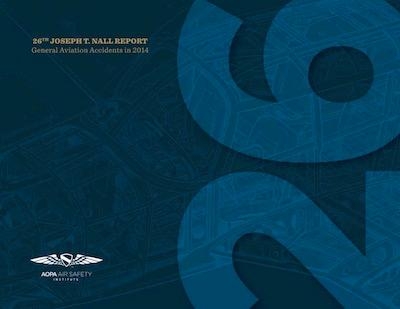AOPA Air Safety Institute Releases 26th Nall Report
The 26th edition of the Joseph T. Nall Report, a review of general aviation accidents for 2014, the most recent year for which reasonably complete data are available, has been released by the AOPA Air Safety Institute (ASI).

The results indicate that the significant improvements and historically low accident rates registered in 2013 “proved not to be a one-time statistical anomaly,” wrote AOPA Air Safety Institute Executive Director Richard McSpadden in his Publisher’s View in the Nall Report. “Across the general aviation community, we can take pride that our collaborative efforts appear to be having a positive, sustained impact.”
The statistics show that there were 952 non-commercial fixed-wing accidents in 2014, compared to 961 in 2013. The number of accidents that involved fatalities was 196, a slight increase over 2013. Pilot-related causes were cited in 75.3 percent of the accidents. A large majority of the accident flights, 76.1 percent, were personal flights, while 13.8 percent were instructional.
“The overwhelming majority of these accidents are avoidable, so if we can convince more pilots to access safety information, we can drive the accident rate even lower, and save lives,” McSpadden said. “That is why numerous industry leaders and type club presidents are joining the Air Safety Institute in a push to reach more private pilots with safety information in a program we call ‘Find one, bring one,’ which encourages pilots to find a pilot not accessing safety information and bring them to safety.”
When addressing type club leaders in July at EAA AirVenture in Oshkosh, Wisconsin, McSpadden’s call to “join together for a call to action” received strong support as he outlined a three-part safety-building strategy consisting of having pilots bring the so-far “unreachable” members of the aviation community into the safety-awareness fold under the “Find one, bring one” plan; get more pilots to join type clubs; and encourage all pilots to focus their training and study on the specific flight realms that continue to cause the most trouble: landings; takeoff and climbs; low-altitude maneuvering; and fuel management.
The Air Safety Institute also released the 2015-2016 GA Accident Scorecard, a brief statistical summary that supplements the Nall Report’s detailed examination of 2014 data. It notes that after arresting a seven-year decline in 2014, noncommercial fixed-wing flight time increased more than five percent in 2015, while the rate of accidents remained at the low level achieved the previous year. The number of fatal accidents declined by two.
In 2016, there was a three-percent increase in accidents, but fatal accidents declined from 20 percent of the total to 16 percent. For the fourth straight year, 2016 had fewer than 1,000 noncommercial fixed-wing accidents, of which fewer than 200 were fatal, “levels not previously seen in the post-World War II era. There were 156 in 2016, 6 percent below the previous record low of 167 recorded three years earlier,” it said.
(Source: AOPA ASI news release)
 Sierra Space Repositions Dream Chaser for First Mission
Sierra Space Repositions Dream Chaser for First Mission ANN's Daily Aero-Term (05.10.24): Takeoff Roll
ANN's Daily Aero-Term (05.10.24): Takeoff Roll Aero-News: Quote of the Day (05.10.24)
Aero-News: Quote of the Day (05.10.24) Aero-News: Quote of the Day (05.11.24)
Aero-News: Quote of the Day (05.11.24) ANN's Daily Aero-Term (05.11.24): IDENT Feature
ANN's Daily Aero-Term (05.11.24): IDENT Feature



